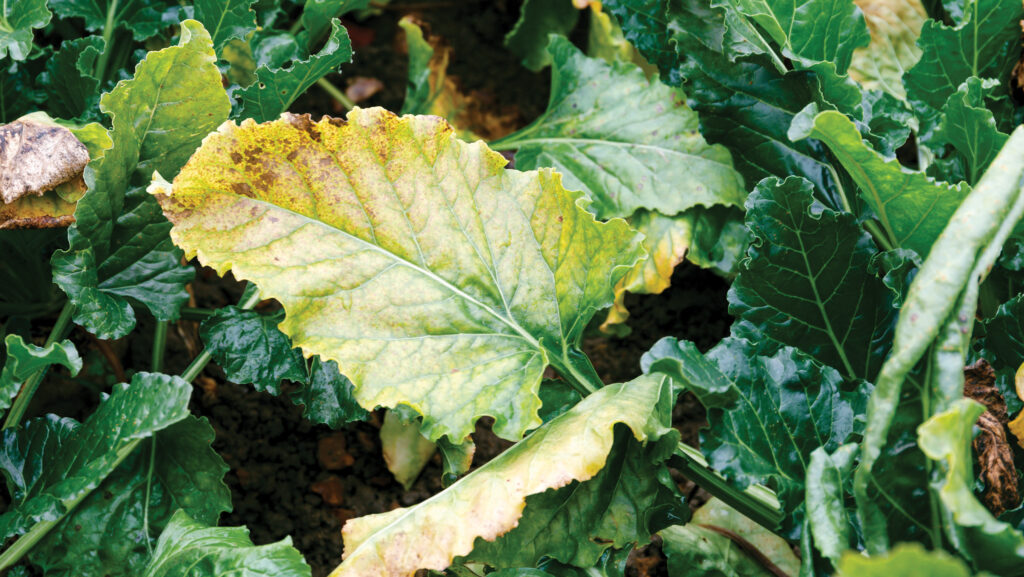Weather helps reduce beet virus yellows risk
 Earlier drilling helps reduce the virus yellows risk to sugar beet plants © GNP
Earlier drilling helps reduce the virus yellows risk to sugar beet plants © GNP Virus yellows risk in sugar beet is reducing following cold weather in January and early February, according to the British Beet Research Organisation’s (BBRO) Prof Mark Stevens.
With the government rejecting an emergency authorisation for the neonicotinoid seed treatment Cruiser SB (thiamethoxam) in late January, helpful weather should help to minimise the impact from aphids transmitting virus yellows, he says.
“The good news is the weather may well be on our side this year. In January, we had grass temperatures down to -9C in East Anglia, and even lower in the Newark factory area.
“Those temperatures are fundamental to killing at least 50% of the population,” says Mark.
See also: How to stop rhizoctonia denting potato yields this spring
“Overall, mean temperature in January were about 3C, which [if that continues through February] means aphids probably aren’t going to be flying until mid-May.”
That’s very different to 2020, when virus yellows incidence in sugar beet crops was extremely high following the rejection of Cruiser SB.
And last year, when aphids were flying in the third or fourth week of March while crops were being drilled or just emerging, he notes.
“Those crops are much more sensitive to virus infection and colonisation, so anything that delays aphids arriving in crops is important to help us mitigate and manage risk.”
The official virus yellows forecast by Rothamsted Research will be available on 1 March. However, with cool or possibly cold weather continuing through to at least mid-February, Mark is hopeful that aphids won’t start flying into crops until at least early May.
He recognises that the need to use Cruiser SB (even if authorisation had been granted) is unlikely to have been triggered due to the weather, but without that safety net, on-farm hygiene is crucial to further minimise risk.
Reducing risk
“Anything that can potentially harbour aphids and virus needs dealing with.
“There was an autumn migration of Myzus persicae into overwintering hosts, such as oilseed rape crops and game cover strips, especially with brassica species.
“Along with sugar beet spoilage heaps, they all provide opportunities for aphids to land and survive through the winter months.”
Earlier drilling potentially helps crops reach the 12 true leaf stage when adult plant resistance to virus yellows begins to take effect.
Unlike previous seasons when treatment with Cruiser SB delayed deliveries, earlier drilling will be easier as seed should be on-farm in good time.
“When to drill will be weather dependent, but an appropriate window will materialise – soil temperatures should be at least 3C and ideally 5C.”
The BBRO will continue to monitor aphid populations through the season.
Initially, it will look at oilseed rape crops in March for overwintering populations, before using yellow water pans and additional assessments in crop to assess regional risks.
Virus content in aphids will also be monitored.
“[Virus content] remains low, but with the caveat that there are some challenges in detecting the levels of beet yellows virus (the most damaging of the three viruses) in the lab.”
Insecticide sprays
The threshold for treatment is one green wingless aphid for every four plants up until the 12 true leaf stage, Mark says.
“Currently, we have two foliar insecticides available in flonicamid (Teppeki or Afinto), which can only be applied once regardless of product, and acetamiprid (Insyst).
“We’ve also applied for an emergency authorisation for a second spray of Insyst. We hope for a decision from the Chemicals Regulation Division by April.
“That would give a three-spray programme unless other products come into the market – there are several others going through approval currently,” Mark says.
Other tactics to control virus yellows could include undersowing of barley.
“It’s a low-cost approach, which removes the contrast between the soil and plant to decrease the numbers of aphids landing in the crop.
“It worked well in 2020 in an early migration, but is likely to be less effective this year with aphids not flying until May.
“The key, if you do use it, is to spray out the barley because weed competition from the barley will have a greater impact on yield even than virus yellows,” he says.
Varietal resistance

Sugar beet crop showing classic symptoms of virus yellows infection © Blackthorn Arable
In the longer term, varietal resistance remains key to minimising or even eliminate risk from virus yellows.
BBRO crop protection scientist Dr Alistair Wright says trials testing new candidate varieties with virus yellows tolerance continue as part of BBRO’s Goliath project, and further tolerance advances are apparent.
In the trials, every sugar beet plant in a block is hand-inoculated with one of the three strains of virus yellows – beet chlorosis (BChV), beet mild yellowing virus (BMYV) and beet yellowing virus (BYV) – creating extremely high pressure.
An uninoculated block is grown for comparison. The blocks are isolated to prevent spread between viruses.
The latest trials show yields of uninoculated candidate varieties (where virus yellows is not present) are starting to improve, reaching 94-98% of controls.
This compares with 88% for Maruscha, the first virus yellows tolerant variety on the Recommended List.
“There’s some encouraging progress coming from a whole range of breeders,” Alistair says.
“Some of the varieties show little or no drop in yield when infected with the poleroviruses, BChV and BMYV.
“But the Achilles heel remains BYV. Typically, we would see a 50% yield drop with BYV, so it is encouraging to see some varieties with only a 20-30% yield loss now.”
Data from the trials are likely to be presented to growers in a classification system, using banding to denote how varieties are expected to perform.
The top category will be A+, where a variety is completely immune or resistant, with no yield loss.
Alistair says this is not yet possible with any of the three viruses, and gene editing is likely to be needed to achieve that.
However, there are varieties in the A band showing less than 10% yield loss for the poleroviruses. Varieties with a B-, C- or D-rating are considered partially tolerant and show 10-20%, 20-30% or 30-40% yield loss.
A nything showing more than a 40% yield loss is considered susceptible.
“You will also need to look at the yield potential of a variety and consider what is your potential for virus yellows and how you’re going to manage it,” Alistair notes.
“But hopefully this information, alongside virus yellows risk, helps make a more informed decision.”
BBRO launches Crop Watch network
The British Beet Research Organisation (BBRO) is launching a centralised hub for its existing and new crop monitoring services.
It aims to make it easier for growers to access local, real-time and data-driven insights into crop growth, pests and disease threats.
BBRO’s Dr Alistair Wright says a total of 20 Crop Watch sites are being set up within the network, including four enhanced sites run by BBRO at its trials sites.
The project is costing £300,000 over three years. Partners include British Sugar, NFU, University of Nottingham, University of Lincoln, and the Association of Independent Crop Consultants.
Information from existing monitoring programmes – such as aphid migration, silver Y and beet moths and cercospora – will be housed within the hub, and can be found on the BBRO website.
From next year, the team hopes it will have its own dedicated portal.
Delta T weather stations will be installed at 16 Crop Watch sites.
PlentySense nitrate soil sensors are being tested at four sites, along with Bayer Magic Traps, which potentially can identify aphid species photographed in water pans using machine learning.
Soil health will be monitored by Fera’s new nematode bioindicator service.
“It’s an opportunity to gain brand new insights. We will be monitoring crop cover regularly, and using apps like Canopeo to look at speed of canopy establishment, which growers can use to benchmark their crops against their local site or one on a similar soil type,” Alistair explains.
“We’re also using new models to give warnings, such as frost risk or summer drought.”
All material for this article was gathered at the Beet Tech 25 conference, held in Norwich in early February.

